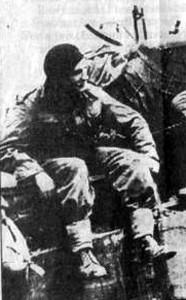George Dring (1917-2003)
THE son of Fulbeck’s village blacksmith, George Dring went to the local school, worked on the land and became a fearless horseman, riding in point-to-points, hunting and showing the impulsive nature which characterised his way of handling his tank.
But it was as Sergeant George “Killer” Dring, he was best known, with a countryman’s eye for terrain, which made him one of the ablest tank commanders in the Sherwood Rangers Yeomanry during the Second World War.
As the regiment advanced across a mined wadi near the Mareth Line in Tunisia in March 1943, Dring realised that the right-hand squadron was being held up by heavy fire from a fortified position to the south. With determination and skill, he moved towards a position where he could control and direct the fire of the heavy squadron.
This brought down fire on his tank. But, undeterred, he succeeded in directing the squadron to such effect that a 50 mm gun was knocked out and an entire infantry position destroyed.
Dring’s citation for his Military Medal attested to his dash, initiative and complete disregard for personal safety, which inspired all ranks.
When the Sherwood Rangers landed in Normandy in 1944 they found the close, heavily wooded country an unsettling experience compared with the Desert, until Dring came to terms with it. By now he was known in the regiment as “Killer” Dring, and had a Sherman tank whose name “Achilles” had turned into “Akilla”.
They were providing armoured support during Operation Epsom near Caen when, as his squadron approached a wood, Dring caught the glint of a Panther tank. He immediately went in for the kill, quickly knocking it out.
Minutes later he used his 17-pounder to destroy a second tank, then took out two more. As a result the whole regiment was able to move forward and enter Fonteray. Dring was awarded a Bar to his MM.
When Dring enlisted in the Sherwood Rangers as a farrier in 1935, the regiment was still mounted; and the Master of the local hunt, the Earl of Yarborough, who had commanded it in the First World War, was still the commanding officer when it mustered at his seat, Welbeck Abbey, in 1939.
As a troop sergeant in the reconnaissance squadron after the breakout from Alamein, Dring developed his practice of leaving his tank turret to take “a shufti” over the crest of hills. He was always in the forefront of action. One close shave came when a shell went straight through his turret and wounded him. As he made his way back to the medical officer, his colonel shook a fist at him for taking risks and received a V-sign in response; within half an hour Dring was back in action.
Not long after winning the Bar to his MM, Dring was refused permission to rescue his badly wounded troop commander because there were some Germans facing him in a strongpoint.
“A few minutes later,” according to a newspaper report, “Sergeant Dring was seen lying on the ground pointing his revolver at eight Germans and beckoning them to advance towards him.” When he had searched them and passed them back, he crawled towards the troop commander and pulled him out of his burning tank.
Dring was seriously wounded on the Siegfried line after he had dismounted to do a recce and came face to face with a Panther which he had thought out of action. It fired, and he lost three fingers.
Although considered completely without fear by the regiment, Dring was badly affected by his experiences. A sturdy, taciturn man, he refused for years to talk about his Army career or watch a war film; sometimes he was too frightened to walk alone along country roads at night.
Following his discharge he worked with prisoners of war and learned German as well as French. Later he worked for the Immigration Service at Southwell.
Dring nursed his wife Kathleen during a long illness. He felt that the regiment should have offered some help and, after she died in 1982, put his medals up for auction; the regiment ended up buying them for a much larger sum than he had been seeking.





Leave a Reply
You must be logged in to post a comment.